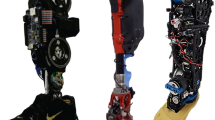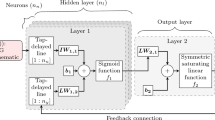Abstract
In this study, artificial neural networks (NN) are applied to the design of a transtibial prosthesis to adapt triplanar and bidirectional movements of human locomotion for rehabilitation. NN-based control is used because the prosthesis system is highly nonlinear and has variables with too many uncertainties caused by variations in ankle movements, weight damping, dorsiflexion, and flexion in the amputation area due to biological stimuli. To identify and detect these movements in the transtibial prosthesis, myoelectric signals are used that determine its position and adapt its trajectory through linear and rotary actuators. The input and desired parameters for the NN controller and the backpropagation algorithm are obtained based on the movements of the human ankle and foot based on their trajectory. The prototype is manufactured from different types of plastic using a 3D grapher, which can perform the main stages of human locomotion due to the learning carried out by the NN, reducing the risk of falls, and having a more comfortable and natural gait cycle in the rehabilitation of people. From the output response obtained from the NN controller, only a time delay is obtained without overshoot terms, and the trajectory tracking is adjusted. Simulation and experimental results show that the proposed NN-based control system can ensure the stability of the system and maintain good tracking of human locomotion.



















Similar content being viewed by others
Explore related subjects
Discover the latest articles, news and stories from top researchers in related subjects.Data availability
The datasets generated during and/or analyzed during the current study are available from the corresponding author on reasonable request.
References
Inegi (2020) Censo de población y vivienda 2020. https://www.inegi.org.mx/temas/discapacidad
Cisneros-González N, Ascencio-Montiel IJ, Libreros-Bango VN, Rodríguez-Vázquez H, Campos-Hernández Á, Dávila-Torres J, Kumate-Rodríguez J, Borja-Aburto VH (2016) Índice de amputaciones de extremidades inferiores en pacientes con diabetes [Lower extremity amputation rates in diabetic patients]. Rev Med Inst Mex Seguro Soc 54(4):472–479
Gordleeva SY, Lobov SA, Grigorev NA, Savosenkov AO, Shamshin MO, Lukoyanov MV, Khoruzhko MA, Kazantsev VB (2020) Real-time eeg-emg human-machine interface-based control system for a lower-limb exoskeleton. IEEE Access 8:84070
Fleming A, Stafford N, Huang S, Hu X, Ferris DP, Huang HH (2021) Myoelectric control of robotic lower limb prostheses: a review of electromyography interfaces, control paradigms, challenges and future directions. J Neural Eng 18:041004
Hamzaid NA, Yusof NHM, Jasni F (2019) Sensory systems in micro-processor controlled prosthetic leg: a review. IEEE Sens J 20(9):4544–4554
Yahya U, Arosha Senanayake SMN, Naim AG (2020) A database-driven neural computing framework for classification of vertical jump patterns of healthy female netballers using 3D kinematics–EMG features. Neural Comput Appl 32:1481–1500
Liu J, Abu Osman NA, Al Kouzbary M, Al Kouzbary H, Abd Razak NA, Shasmin HN, Arifin N (2021) Classification and comparison of mechanical design of powered ankle-foot prostheses for transtibial amputees developed in the 21st century: a systematic review. J Med Devices 15:010801
Nasr A, Laschowski B, Mcphee J (2021) Myoelectric control of robotic leg prostheses and exoskeletons: a review. In: International design engineering technical conferences and computers information in engineering conference, vol 85444, p V08AT08A043
Weerakkody TH, Lalitharatne TD, Gopura RARC (2017) Adaptive foot in lower-limb prostheses. J Robot. https://doi.org/10.1155/2017/9618375
Ahkami B, Ahmed K, Thesleff A, Hargrove L, Ortiz-Catalan M (2022) Electromyography-based control of lower limb prostheses: a systematic review
Aragon FC, Huegel JC, Vargas-Martinez A, Lozoya-Santos JDJ, Ramirez-Mendoza R, Morales-Menendez R (2019) Comparison between classic control systems techniques against adaptive and nonlinear control techniques in a lower limb prostheses. In: 2019 4th International conference on control and robotics engineering (ICCRE), IEEE. pp 75–78
Abdallah W, Boucetta R, Ali SBH (2019) An adaptive Fuzzy-PID control of a lower limb active prosthesis under external perturbations. In: 2019 16th International multi-conference on systems, signals & devices (SSD), IEEE. pp 96–101
Cimolato A, Driessen JJ, Mattos LS, De Momi E, Laffranchi M, De Michieli L (2022) EMG-driven control in lower limb prostheses: a topic-based systematic review. J Neuroeng Rehabil 19(1):1–26
Mehmood A, Zameer A, Ling SH, Rehman AU, Raja MAZ (2020) Integrated computational intelligent paradigm for nonlinear electric circuit models using neural networks, genetic algorithms and sequential quadratic programming. Neural Comput Appl 32:10337–10357
Demir F, Bajaj V, Ince MC, Taran S, Şengür A (2019) Surface EMG signals and deep transfer learning-based physical action classification. Neural Comput Appl 31:8455–8462
Lokesh S, Malarvizhi Kumar P, Ramya Devi M, Parthasarathy P, Gokulnath C (2019) An automatic tamil speech recognition system by using bidirectional recurrent neural network with self-organizing map. Neural Comput Appl 31:1521–1531
Hopgood AA (2021) Intelligent systems for engineers and scientists: a practical guide to artificial intelligence. CRC Press
Bodin ON, Solodimova GA, Spirkin AN (2020) The manipulation of bionic prosthesis using neural network processing information principles. In: 2020 Moscow workshop on electronic and networking technologies, p 1–4
Ugbolue UC, Robson C, Donald E, Speirs KL, Dutheil F, Baker JS, Gu Y (2021) Joint angle, range of motion, force, and moment assessment: responses of the lower limb to ankle plantarflexion and dorsiflexion. Appl Bio Biomech. https://doi.org/10.1155/2021/1232468
da Silva IN, Hernane Spatti D, Andrade Flauzino R, Liboni LH, dos Reis Alves SF (2017) Artificial neural network architectures and training processes. Springer
Tan HH, Lim KH (2019) Review of second-order optimization techniques in artificial neural networks backpropagation. In: IOP conference series: materials science and engineering, vol 495, no. 1, p 012003. IOP Publishing
Alanis AY, Arana-Daniel N, Lopez-Franco C (2019) Artificial neural networks for engineering applications. Academic Press
Vlachas PR, Pathak J, Hunt BR, Sapsis TP, Girvan M, Ott E, Koumoutsakos P (2020) Backpropagation algorithms and reservoir computing in recurrent neural networks for the forecasting of complex spatiotemporal dynamics. Neural Netw 126:191–217
Apicella A, Donnarumma F, Isgrò F, Prevete R (2021) A survey on modern trainable activation functions. Neural Netw 138:14–32
Whittington JC, Bogacz R (2019) Theories of error back-propagation in the brain. Trends Cogn Sci 23(3):235–250
Lillicrap TP, Santoro A, Marris L, Akerman CJ, Hinton G (2020) Backpropagation and the brain. Nat Rev Neurosci 21(6):335–346
Huang JC, Ko KM, Shu MH, Hsu BM (2020) Application and comparison of several machine learning algorithms and their integration models in regression problems. Neural Comput Appl 32:5461–5469
Narkhede MV, Bartakke PP, Sutaone MS (2022) A review on weight initialization strategies for neural networks. Artif Intell Rev 55(1):291–322
Gariboldi F, Pasquarelli D, Cutti AG (2022) Structural testing of lower-limb prosthetic sockets: a systematic review. Med Eng Phys 99:103742
Gregg Richardson TX (US), R., Toby B. Elery, Farmers Branch, TX (US), Nesler Austin TX (US), C., & (us), S. R. A. (2019). Powered prosthesis with torque dense, low ratio actuation (Patent Núm. 20190328551 Al). En US Patent (20190328551 Al).
Ipsey, J., 355 East Erie Street, Chicago, Illinois 60611 (US). PICKERILL, Tom, & 355 East Erie Street, Chicago, Illinois 60611 (US). (2022). Systems and methods for an ankle prosthesis (Patent Núm. 2022047364 Al). En World Patent (2022047364 Al).
Alleva S, Antonelli MG, Beomonte Zobel P, Durante F (2020) Biomechanical design and prototyping of a powered ankle-foot prosthesis. Materials 13(24):5806
Debta S, Kumar K (2018) Biomedical design of powered ankle-foot prosthesis—a review. Mater Today: Proc 5(2):3273–3282
Widhiada IW, Budiarsa IN, Widiyarta IM, Coglitore T (2019) Comparison of PID and fuzzy logic to control the motions of robotic prosthetic limbs. In: IOP conference series: materials science and engineering, vol 673, no 1, p 012109. IOP Publishing
Zaitceva I, Andrievsky B (2022) Methods of intelligent control in mechatronics and robotic engineering: a survey. Electronics 11(15):2443
Pană CF, Manta LF, Vladu IC, Cismaru ŞI, Petcu FL, Cojocaru D, Bîzdoacă N (2022) The design of a smart lower-limb prosthesis supporting people with transtibial amputation—a data acquisition system. Appl Sci 12(13):6722
Acknowledgements
This work was supported by the Tecnologico Nacional de Mexico of the Tecnologico de Estudios Superiores de Ecatepec.
Author information
Authors and Affiliations
Contributions
Experimental were from L-C and A-V. Data collection was performed by M-O, de la C-A. Data analysis was performed by de la C-A and L-C. The first draft was written by de la C-A and L-C, and M-O reviewed and edited the draft. All authors commented on previous versions of the manuscript. All authors read and approved the final manuscript and agree with the order of presentation of the authors.
Corresponding author
Ethics declarations
Conflict of interest
The authors declare no competing interests.
Additional information
Publisher's Note
Springer Nature remains neutral with regard to jurisdictional claims in published maps and institutional affiliations.
Rights and permissions
Springer Nature or its licensor (e.g. a society or other partner) holds exclusive rights to this article under a publishing agreement with the author(s) or other rightsholder(s); author self-archiving of the accepted manuscript version of this article is solely governed by the terms of such publishing agreement and applicable law.
About this article
Cite this article
de la Cruz-Alejo, J., Lobato-Cadena, J.A., Arce-Vázquez, M.B. et al. Predicting triplanar and bidirectional movements for a transtibial prosthesis for rehabilitation using intelligent neural networks. Neural Comput & Applic 36, 6085–6098 (2024). https://doi.org/10.1007/s00521-023-09393-0
Received:
Accepted:
Published:
Issue Date:
DOI: https://doi.org/10.1007/s00521-023-09393-0




